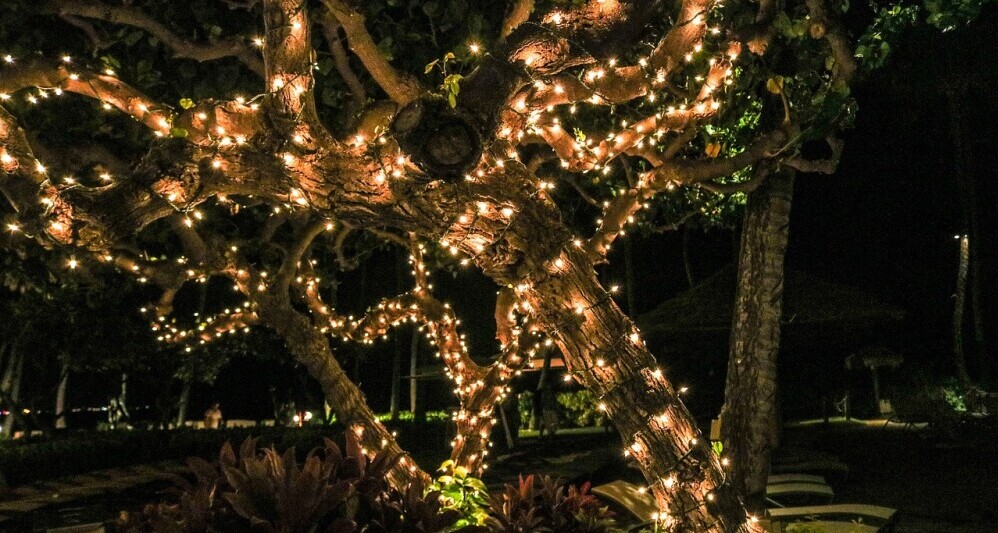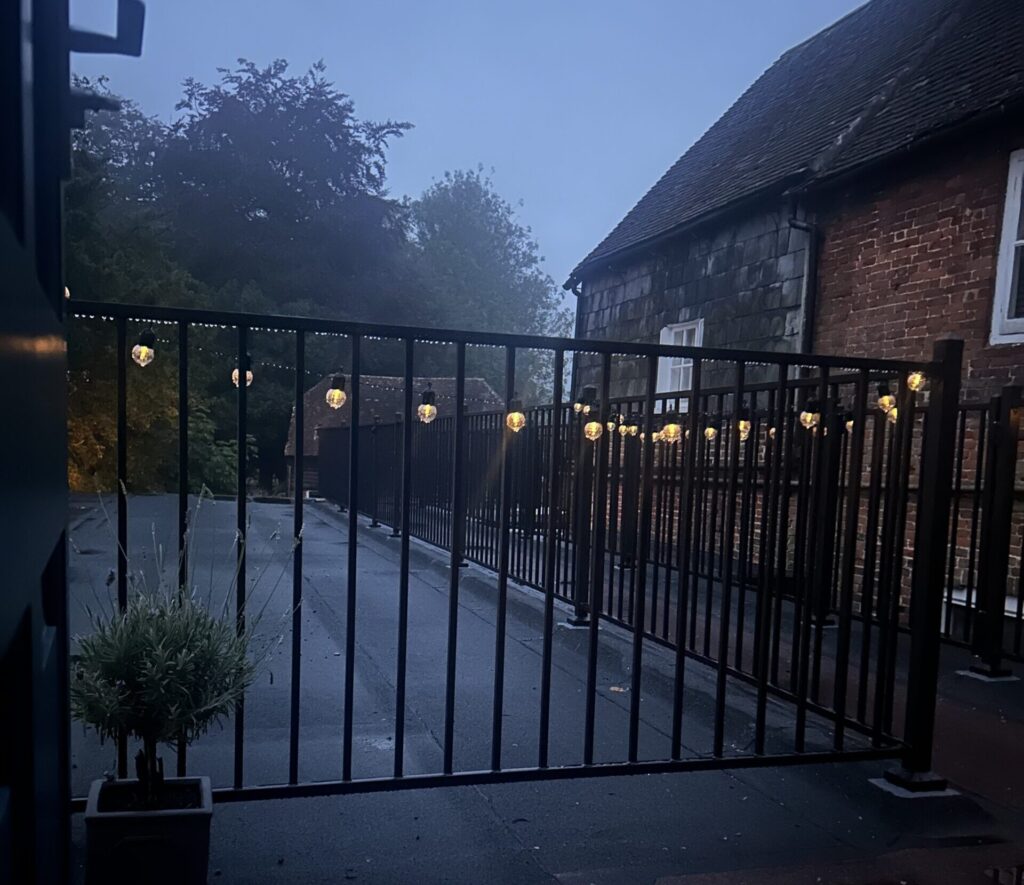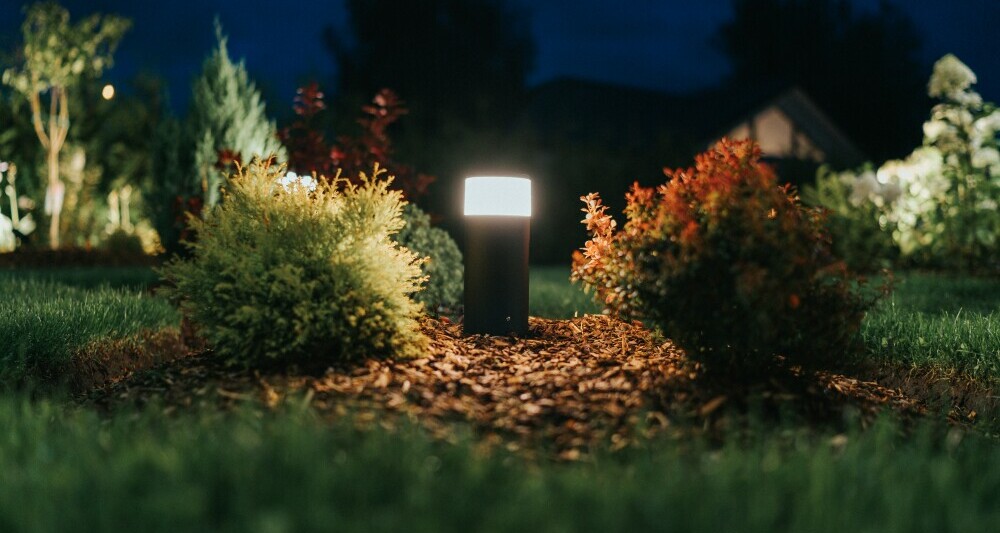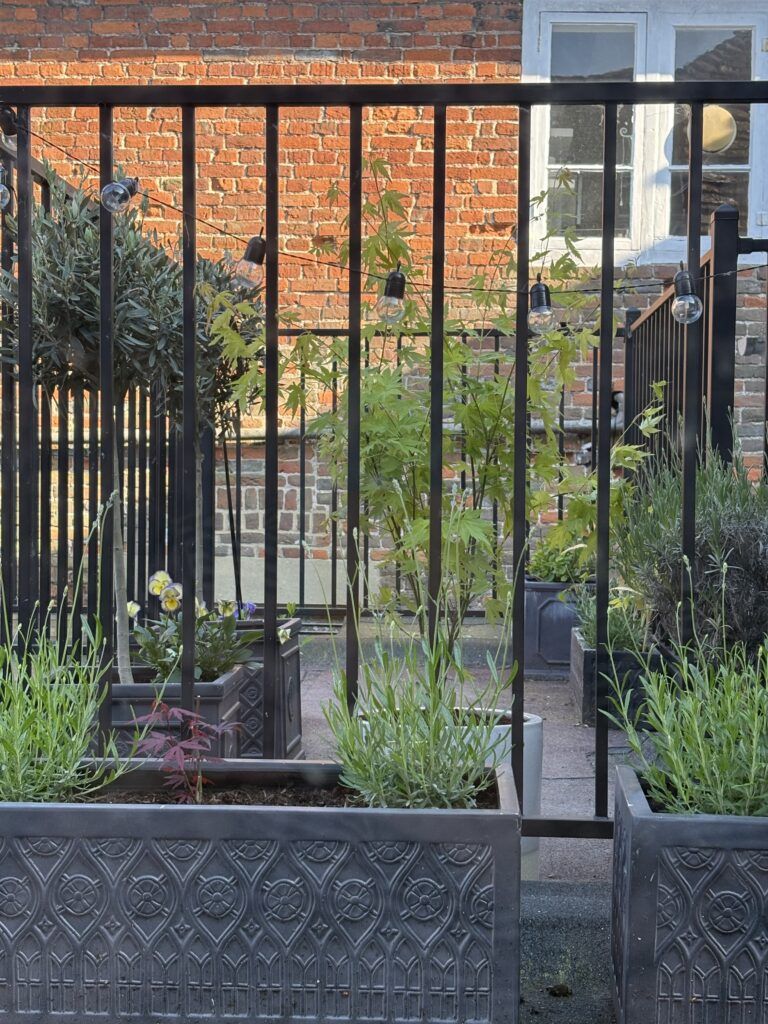Ultimate Guide to Outdoor Living Space Lighting: Garden, Patio & Deck Ideas
Discover the best outdoor lighting ideas for gardens, patios & decks. Learn placement, safety tips & the top LED, solar & smart lights for style & security.
Lighting your outdoor living area can totally change how you use and enjoy your space once the sun goes down. With the perfect setup, patios, decks, gardens, and balconies transform into go-to retreats for relaxing, eating, or entertaining well past sunset. I’ve put together this guide with everything I’ve learned, so you can plan, install, and keep outdoor lighting looking sharp and stress-free.
Garden Nest Living grew from a simple idea: to share my love of gardens and creating calm, beautiful spaces, both inside and out. When you buy through my affiliate links, you are allowing me to keep sharing inspiration, ideas and products… at no extra cost to you. Thank you for being a part of my journey!

Why Outdoor Lighting Matters for Gardens, Patios & Decks
Outdoor lighting does more than just brighten up the garden—it stretches your living space into the evening, adds a safety boost, and really brings the whole vibe outside together. The right lights can pull people outside who would have usually headed back indoors. Extend Your Living Space Into the Evening
- Stay outside longer, whether you’re cooking, working, or relaxing under the night sky.
Improve Safety and Security Outdoors
- Well-lit steps, driveways, and entryways help prevent accidents, and a few smart lights can help keep intruders at bay.
Boost Curb Appeal and Home Value
- Lighting brightens up landscaping, architectural details, and highlights focal points—adding a little drama and interest to your spaces.
- They also add curb appeal and can even increase resale value if selling pops up on your radar.
You’ll also notice perks like smoother navigation after dark and a great first impression for visitors. For me, the biggest gain was getting a whole new living room vibe outdoors by just flipping a switch.
How to Use Layered Outdoor Lighting (Ambient, Task & Accent)
Getting layered lighting right outdoors is just as important as it is indoors. That means mixing up different types of fixtures and lights for a space that feels balanced, practical, and comfy—never overwhelming, and not too dim either.
Ambient Lighting for Atmosphere
- General glow for mood. Think lanterns, wall lights, overhead pendants, or string lights. These set the scene without being harsh.
Task Lighting for Safety and Function
- Focused light for work zones like BBQ stations, dining tables, or steps. Deck lights, bollards, and steplights let you see what you’re doing when you need to.
Accent Lighting to Highlight Features
- Shows off favourite features such as trees, fountains, sculptures, or cool architecture. Spotlights, uplights, and well lights are my picks here.
This mix makes outdoor areas usable and next-level cool, while giving you options for changing the mood whenever you feel like it.

Best Outdoor Lighting Options: LED, Solar, Low-Voltage & Smart Lights
Picking the right outdoor lighting might feel a bit overwhelming at first, but breaking it down helps simplify things. Here’s a quick rundown of the most popular choices and what works best out there in the real world.
Why LEDs Are the Most Versatile Choice
- Long-lasting (often 20,000 to 50,000 hours!), energy efficient, and available in tons of colour temperatures. These are my top pick—they look great, work anywhere, and need barely any maintenance.
When to Use Solar Lights
- Easy to DIY, eco-friendly, and wireless. I use them for subtle path lighting, but keep in mind they’re not always super bright or totally reliable in larger spaces or for key tasks.
Benefits of Low-Voltage Lighting Systems
- Safe, expand easily, and are perfect for both mood and task lighting. These are the way to go if you want something that’ll last and handle weather without a fuss.
Smart Lighting for Convenience and Control
- App control, timers, motion sensors, scene settings—all work right from your phone. Plugging in a smart transformer makes operating the system much easier… and fun. Tech fans will love the added convenience.
Understanding Outdoor Lighting IP Ratings
Always check that your chosen fixtures are “wet-rated” or “damp-rated” as the space requires. It matters for safety and how long your lights stick around. Outdoor lighting uses the IP rating system—IP44 for patios, IP65 for the garden, and IP68 if you want to light up water features. Unsure? You can find more info about IP ratings at places like Lighting Direct.

Where to Place Outdoor Lights for Safety, Style & Functionality
Where you put your lights matters more than just making things bright. The best setups use soft, well-placed lights, not harsh, direct beams. Here’s where lighting makes the biggest difference:
Pathways and Steps
- Bollards, lanterns, or decklights keep people safe and guide you after dark.
Entrances and Driveways
- Wall lanterns, statement lights on gateposts, or motion sensors for added visibility and security.
Patios and Decks
- Recessed lighting, fairy lights, or sconces help create the right mood for spending time with family & friends.
Gardens, Beds and Trees
- Uplights and spike lights can turn plants and trees into focal points after sunset.
Porches and Balconies
- Hanging lanterns, ceiling fixtures, and soffit lights give these spots just the right brightness.
If your house has vintage character like ours, choosing handmade or period fixtures can give your curb appeal a serious boost and keep things feeling put together.
Outdoor Lighting for Safety & Home Security
Outdoor lighting’s not just about looking good—it’s a real help for safety and security, too. Steps, driveways, and dark corners should be high-priority spots. Here are a few key ideas:
Motion Sensor Floodlights
- Place these by entrances, garages, and side paths. They light up when you need them and can ward off unwanted guests.
Step and Pathway Lighting
- Hazards fade away when lights are spaced every 5 to 7 feet along the walkway. That’s the handy “5 7 lighting rule.”
Perimeter and Entry Lighting
- Add a few lights around the garden edges or by the front door so you can spot movement and keep visitors feeling welcome.
Play it smart with subtle, downward-aimed lights to dodge glare and create a natural vibe rather than blinding spots.
Stylish Lighting Ideas for Driveways, Patios, Gardens & More
Driveways and Gateposts
- Driveways: Bollards, driveover lights, and coach lanterns clearly outline the way and help with parking.
- Gateposts: Plinth lights or bold lanterns make entranceways pop, which is especially useful for welcoming guests or deliveries.
Porches and Entrances
- Porches: Hanging lanterns or wall lights blend charm with function, making it easy to find the keyhole at night.
Patios, Decks and Balconies
- Patios and Decks: Decking lights, wall-mounted fixtures, or tucked-away brick lights bring just the right glow for relaxing or entertaining, without going overboard.
- Balconies and Small Gardens: Recessed ceiling or bulkhead lights do the trick, and for renters, battery-powered or plugin strip lights work well too.
Period Homes and Heritage Lighting
- Stick with handmade or vintage looks to match architecture and keep the style on point.
Garden Lighting Inspiration: Blending Security with Style in Outdoor Spaces
In our Georgian home, we’re fortunate to enjoy both a roof garden and a back garden. To bring these spaces together, we wanted a lighting scheme that was both practical and inviting. For safety, security, and everyday use, we installed outdoor sensor lamps on the railings, entrance gate, and above the door. To add warmth and charm, we complemented them with solar-powered festoon lights draped along the railings, creating a welcoming atmosphere. The key is finding the perfect balance between functional lighting for safety and decorative touches that make the space feel like home.
Please note, we had a qualified electrician fit all of our outdoor lighting. I just draped the festoon solar-powered lights on the railings.

Festoon Solar-Powered fairy lights draped over the railings on our roof garden.
Our exterior stairs leading to our roof garden with outside lighting fitted for safety.
Design Tips: How to Create a Beautiful & Practical Outdoor Lighting Scheme
Match Fixtures to Your Home’s Style
- Match lighting styles and finishes with your home and landscaping to keep things feeling coordinated.
Choose Durable, Weatherproof Materials
- Pick tough, weatherproof fixtures so you don’t have to replace them every season.
Layer Lighting for Flexibility
- Layer different types of lights for the right mix through any activity—dining, relaxing, or just making your way safely.
Use Smart Controls and Sensors
- Add timers, smart home setups, or dusk-to-dawn sensors to cut energy use and save hassle.
- Go for LEDs for longer life and efficiency, even if they cost a little extra upfront.
Outdoor Lighting Maintenance: Keep Fixtures & Bulbs Lasting Longer
Seasonal Cleaning and Bulb Checks
Keeping your lights shining bright doesn’t take much work. I usually make a quick garden walk every season, cleaning fixtures, checking for burned-out bulbs, and tweaking locations as plants get bigger.
Protecting Wires and Fixtures from Damage
Aim fixtures away from constant rainfall, and don’t forget to inspect wires for any wear.
Extending the Life of LEDs and Solar Panels
Swapping out LEDs is rare, but don’t forget to check on transformers or solar panels for dirt or issues.

Grand Design Magazine has a really good Outdoor Lighting Guide if you want to check it out; “As dusk falls, transform your garden into an atmospheric space to enjoy with this outdoor lighting guide to add texture and depth and illuminate your planting.”
Outdoor Lighting Checklist: Best Lights for Every Garden Area
| Garden Area | Best Light Types | Examples / Suggestions | Purpose |
|---|---|---|---|
| Pathways & Steps | Task & Safety Lighting | Bollard lights, step lights, recessed deck lights | Prevent trips, guide movement safely |
| Driveways | Functional & Statement Lighting | Drive-over lights, bollards, post lanterns | Visibility, curb appeal, safe parking |
| Entrances & Porches | Ambient + Security Lighting | Hanging lanterns, wall sconces, motion sensor lights | Welcome guests, improve safety, deter intruders |
| Patios & Decks | Ambient & Task Lighting | Decking lights, wall-mounted lanterns, string lights | Dining, entertaining, cozy evening atmosphere |
| Garden Beds | Accent Lighting | Spike lights, ground uplights, LED strips | Highlight flowers, borders, and planting areas |
| Trees & Focal Points | Accent & Decorative Lighting | Spotlights, uplights, floodlights | Showcase trees, sculptures, or water features |
| Balconies & Gardens | Compact Ambient Lighting | Bulkhead lights, recessed soffit lights, fairy lights | Small-space ambience, subtle mood lighting |
| Period Homes | Heritage & Character Lighting | Handmade lanterns, vintage wall lights | Match architecture, enhance curb appeal |
| Perimeter & Fences | Security + Ambient Lighting | LED floodlights, directional wall lights | Deter intruders, softly outline boundaries |
| Water Features | Waterproof Accent Lighting (IP68-rated) | Submersible spotlights, pond lights | Highlight fountains, ponds, and water detail |
Outdoor Lighting Comparison: LED vs. Solar vs. Low-Voltage
| Lighting Type | Pros | Cons | Best For |
|---|---|---|---|
| LED Lights | – Extremely energy-efficient – Very long lifespan (20,000–50,000 hrs) – Wide range of styles & color temperatures – Low maintenance | – Higher upfront cost – May require professional installation for wired systems | General garden & patio use, accent lighting, long-term investment |
| Solar Lights | – Easy DIY installation – Eco-friendly & wireless – Low-cost, no electricity bills – Great for temporary setups | – Dependent on sunlight – Less bright & not ideal for large/task areas – Shorter lifespan | Path lighting, decorative accents, renters or temporary solutions |
| Low-Voltage Systems | – Safe to install & expand – Reliable, consistent brightness – Handles weather well – Flexible for both task & mood lighting | – Requires transformer & wiring – More complex setup – Higher upfront investment | Permanent setups, large gardens, task lighting (e.g., steps, driveways) |
Authoritative Lighting Resources: Safety Measures & IP Ratings
Screwfix have a good guide to outdoor lighting including safety measures & IP Ratings. Read the full article HERE.
“To avoid the dangers of mixing electricity with water and dust particles, all outdoor lighting must meet certain requirements set out by BS and CE standards. So, they are given an IP (ingress protection) rating.
As a guide, select an IP43 rated light to go under a roof, IP44 for a light exposed to light rain, IP65 for a light exposed to heavy rain and IP68 for a light that will be submerged in water.“
NICEIC have created a Garden & Electrics ‘What You Need To Know’, including finding a trusted tradesperson. Read the full article HERE.
“Gardens can offer a haven away from the stresses of day-to-day life. However, even this area of the home can pose a variety of risks when it comes to electrical safety. We have compiled our top safety tips to help you address these hazards and maintain your perfect outdoor space…”
Frequently Asked Questions About Outdoor Lighting
Why is outdoor lighting important for my outdoor living space?
Outdoor lighting is essential for safety, security, and style. It extends the usable hours of your patio, garden, or deck while highlighting landscaping and architecture. The right lighting creates a warm, welcoming atmosphere so you can enjoy your outdoor living space day or night.
What type of outdoor lighting is best—LED, solar, low-voltage, or something else?
LED lighting is the best choice for most outdoor living spaces because it’s energy-efficient, long-lasting, and available in many styles. Solar lights are eco-friendly and easy to install but less powerful, while low-voltage systems provide reliable performance and flexibility for larger or more complex garden designs.
Where should I place outdoor lights for safety, beauty, and functionality?
Place outdoor lights along paths, driveways, and steps for safety, near doors for convenience, and around patios or decks for ambience. Use layered lighting: ambient for overall glow, task lights for cooking or movement, and accent lights to highlight trees, walls, or water features.
What type of lighting should be used in outdoor areas?
For outdoor areas, choose durable, weather-rated fixtures like LEDs for energy savings and longevity. Lanterns or pendants provide general illumination, bollards and step lights improve safety, while uplights and spotlights showcase landscaping or architectural features. Always select wet- or damp-rated fixtures to withstand the elements.
Final Thoughts: Creating a Safe & Stylish Outdoor Living Space
Lighting your outdoor living space is more than just a design choice—it’s what transforms a garden, patio, or balcony into a welcoming extension of your home. With the right mix of ambient, task, and accent lighting, you can highlight your landscape, improve safety, and create the perfect atmosphere for relaxing or entertaining after dark. Whether you choose LEDs, solar, or low-voltage systems, thoughtful planning ensures your outdoor area becomes a year-round retreat that is practical, stylish, and uniquely yours.
Author Bio: My Journey into Gardening & Outdoor Design
I grew up surrounded by the rural beauty of the Hampshire countryside, where my earliest dream was to work with animals. After finishing school, I studied at Sparsholt College and earned a National Diploma in Animal Management.
Life, as it often does, took me in a different direction. I built and ran another business, got married, and became a proud mum to three wonderful boys. After the birth of my youngest in 2020, I found myself at a crossroads, ready for a new career. Gardening—something that had always been a passion—was the natural choice.
I’ve now been working as a self-employed gardener in Hampshire for over five years, but my love for gardening began long before that. Growing up, I spent countless hours outside helping my parents, both keen gardeners (with three allotments!). Being outdoors, nurturing plants, and watching gardens transform with the seasons has always brought me joy.
While much of my knowledge has come through hands-on gardening experience, trial and error, and plenty of research, I’ve also relied heavily on trusted resources like the Royal Horticultural Society, which has guided me in becoming a confident, self-taught gardener.
Now, through Garden Nest Living, I want to share that journey and help others create outdoor spaces that grow with them. A garden doesn’t have to stop at the flowerbeds — it can extend into an inviting living area where you dine, relax, and celebrate the seasons as they unfold. With the right mix of planting, design, and comfort, your garden can become a year-round retreat that’s both beautiful and practical.

Close up of our festoon fairy light bulbs.

Festoon fairy lights draped on our black railings on our roof garden.


I really appreciate how you broke down the lighting into ambient, task, and accent categories; it made everything so much clearer for me! My sister recently finished renovating her home, and we’ve been brainstorming ideas to make her outdoor space both cozy and practical. She wants it to feel welcoming for family dinners while also adding a touch of elegance for gatherings with friends.
This guide gave us many fresh ideas, especially regarding layered lighting and using LEDs for efficiency. I hadn’t considered uplighting trees or incorporating subtle step lights for safety, but those details would make a significant difference.
Thank you for putting this together! I’ll be sharing it with her as we decide what will work best for her new space.
When we moved into our house a few years ago, we lit the outside areas for security, as the garden was very dark at night, and there is a huge park across the street with some unsavory characters.
However since then we have added more lights around the pool as it is so nice to sit around it at night in the summer months. We also did some task lighting around the barbeque area so we could see what we were doing.
I would however love to add some more lights targeting the ambient side so that we can create more of a mood, especially for entertainment. Do you think lanterns or string lights will be better for around a pool?
Thanks for sharing your lighting journey — it sounds like you’ve created a really practical and welcoming space already! Adding ambient lighting is a great next step, especially if you enjoy entertaining.
For a poolside setting, both lanterns and string lights can work beautifully, but they create slightly different moods:
Lanterns (especially solar or LED versions) give a warm, cozy, more intimate glow. They’re also flexible since you can move them around depending on the occasion.String lights tend to feel more festive and can frame the pool area nicely, especially if you drape them overhead or along a fence.
If you’d like a softer, more “resort-like” mood, lanterns might be best. If you want that lively, party atmosphere, string lights are the way to go — and sometimes a combination of both strikes the perfect balance.
Great post — I really enjoyed how you broke outdoor lighting into ambient, task, and accent layers. It’s so helpful to see practical examples like step lights for safety and uplights to highlight garden features, rather than just generic advice. I also liked your explanation of IP ratings and why wet- or damp-rated fixtures are essential outdoors. For those of us working on a budget, do you have any favourite DIY or budget-friendly lighting ideas that still look stylish and last through the seasons?
Thank you so much for the thoughtful comment — I’m glad you found the breakdown of lighting layers and IP ratings useful! For budget-friendly ideas, I’m a big fan of solar-powered stake lights and string lights; they’re affordable, easy to install, and come in designs that look surprisingly stylish these days. Another great option is using LED puck or strip lights tucked under benches, railings, or planters — they give a high-end look without the high-end cost, and LEDs hold up really well outdoors. For a DIY touch, you can even repurpose mason jars or lanterns with battery or solar inserts to create custom accent lighting. The key is to mix a few of these solutions so your garden feels layered and intentional, even on a budget.
This is exactly the outdoor lighting guide I’ve been looking for!
I’ve been struggling with lighting my backyard properly, and this guide answered all my questions. The breakdown of ambient, task, and accent lighting was a game-changer – I finally understand how to create layers instead of just randomly placing lights everywhere.
The safety tips really resonated with me too. The “5-7 foot spacing rule” for pathways is exactly the practical advice I needed, and I never considered how important proper lighting is for elderly visitors until reading this.
Your comparison of LED vs solar vs low-voltage systems was incredibly helpful. I was leaning toward solar for simplicity, but after understanding their limitations, I’m convinced that investing in a proper low-voltage system is the way to go for my larger space.
I also love how you addressed different architectural styles – our Victorian home needs period-appropriate fixtures, and your suggestions for maintaining that character while adding functionality were spot on.
The maintenance section was a nice bonus that most guides skip. Your seasonal checklist is going straight into my routine.
Thanks for such a thorough and practical resource – I’m bookmarking this and definitely sharing with friends who are planning their own outdoor lighting projects!
I believe this guide covers everything thoroughly. Even though I didn’t know much about layered lighting before, reading this article showed me how much it can transform the feel and function of an outdoor space. I really liked the practical safety tips and the creative ideas for ambience. Even small additions like string lights or step lights can turn a basic patio or garden into a warm and welcoming space after dark.